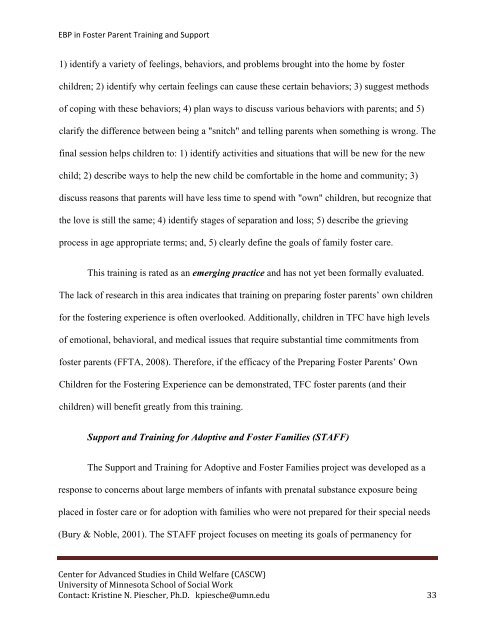Evidence-Based Practice in Foster Parent Training and Support ...
Evidence-Based Practice in Foster Parent Training and Support ...
Evidence-Based Practice in Foster Parent Training and Support ...
Create successful ePaper yourself
Turn your PDF publications into a flip-book with our unique Google optimized e-Paper software.
EBP <strong>in</strong> <strong>Foster</strong> <strong>Parent</strong> Tra<strong>in</strong><strong>in</strong>g <strong>and</strong> <strong>Support</strong>1) identify a variety of feel<strong>in</strong>gs, behaviors, <strong>and</strong> problems brought <strong>in</strong>to the home by fosterchildren; 2) identify why certa<strong>in</strong> feel<strong>in</strong>gs can cause these certa<strong>in</strong> behaviors; 3) suggest methodsof cop<strong>in</strong>g with these behaviors; 4) plan ways to discuss various behaviors with parents; <strong>and</strong> 5)clarify the difference between be<strong>in</strong>g a "snitch" <strong>and</strong> tell<strong>in</strong>g parents when someth<strong>in</strong>g is wrong. Thef<strong>in</strong>al session helps children to: 1) identify activities <strong>and</strong> situations that will be new for the newchild; 2) describe ways to help the new child be comfortable <strong>in</strong> the home <strong>and</strong> community; 3)discuss reasons that parents will have less time to spend with "own" children, but recognize thatthe love is still the same; 4) identify stages of separation <strong>and</strong> loss; 5) describe the griev<strong>in</strong>gprocess <strong>in</strong> age appropriate terms; <strong>and</strong>, 5) clearly def<strong>in</strong>e the goals of family foster care.This tra<strong>in</strong><strong>in</strong>g is rated as an emerg<strong>in</strong>g practice <strong>and</strong> has not yet been formally evaluated.The lack of research <strong>in</strong> this area <strong>in</strong>dicates that tra<strong>in</strong><strong>in</strong>g on prepar<strong>in</strong>g foster parents’ own childrenfor the foster<strong>in</strong>g experience is often overlooked. Additionally, children <strong>in</strong> TFC have high levelsof emotional, behavioral, <strong>and</strong> medical issues that require substantial time commitments fromfoster parents (FFTA, 2008). Therefore, if the efficacy of the Prepar<strong>in</strong>g <strong>Foster</strong> <strong>Parent</strong>s’ OwnChildren for the <strong>Foster</strong><strong>in</strong>g Experience can be demonstrated, TFC foster parents (<strong>and</strong> theirchildren) will benefit greatly from this tra<strong>in</strong><strong>in</strong>g.<strong>Support</strong> <strong>and</strong> Tra<strong>in</strong><strong>in</strong>g for Adoptive <strong>and</strong> <strong>Foster</strong> Families (STAFF)The <strong>Support</strong> <strong>and</strong> Tra<strong>in</strong><strong>in</strong>g for Adoptive <strong>and</strong> <strong>Foster</strong> Families project was developed as aresponse to concerns about large members of <strong>in</strong>fants with prenatal substance exposure be<strong>in</strong>gplaced <strong>in</strong> foster care or for adoption with families who were not prepared for their special needs(Bury & Noble, 2001). The STAFF project focuses on meet<strong>in</strong>g its goals of permanency forCenter for Advanced Studies <strong>in</strong> Child Welfare (CASCW)University of M<strong>in</strong>nesota School of Social WorkContact: Krist<strong>in</strong>e N. Piescher, Ph.D. kpiesche@umn.edu 33
















